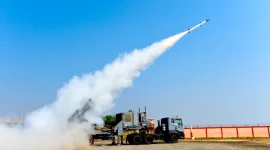- Views: 6K
- Replies: 38
The Brazilian Air Force (FAB) is actively assessing potential replacements for its long-serving Northrop F-5FM Tiger II jets, marking a significant step in its ongoing fleet modernization program.
Facing the need to retire these decades-old aircraft, Brazil is considering distinct proposals from India and Pakistan, pitting the Indian-made Tejas Mk1A against the Pakistani-Chinese jointly developed JF-17 Block III.
The FAB's modernisation drive aims to enhance its capabilities to meet contemporary defence and security challenges, particularly across Brazil's vast territory, including the demanding Amazon region.
While the advanced Saab F-39 Gripen NG now serves as Brazil's primary fighter, the air force requires a more cost-effective, lightweight aircraft to complement the Gripen fleet.
This new aircraft would undertake essential roles such as air policing, ground attack operations, and other secondary combat duties, replacing the capabilities of the outgoing F-5s.
Approximately 40 F-5FM Tiger II jets remain in service but are approaching the end of their operational lifespan and are scheduled for retirement in the coming years.
These third-generation fighters, operational since the 1970s, lack the modern avionics, sensors, and versatility needed for current aerial warfare scenarios. This requirement has drawn international interest, leading to formal offers from both Pakistan and India.
Pakistan formally presented its JF-17 Block III proposal in early April 2025, offering detailed information on the aircraft's capabilities. Developed collaboratively by the Pakistan Aeronautical Complex (PAC) and China's Chengdu Aircraft Corporation (CAC), the JF-17 has been a key asset for the Pakistan Air Force since 2007.
The latest Block III variant, which became operational in 2024, incorporates significant upgrades, including an Active Electronically Scanned Array (AESA) radar, advanced flight control systems, an Infrared Search and Track (IRST) system, and a Helmet-Mounted Display (HMD).
India has countered with its Tejas Mk1A, a 4.5-generation fighter developed indigenously by Hindustan Aeronautics Limited (HAL). The Tejas is noted for its General Electric F404 engine, which provides a high thrust-to-weight ratio, potentially exceeding that of the JF-17.
It features a maximum speed of Mach 1.8, a combat range cited at 500 km with external fuel tanks, and a weapon payload capacity of 5,300 kg. The extensive use of composite materials in its construction contributes to a lower radar cross-section compared to the JF-17.
The estimated unit cost for the Tejas Mk1A is approximately $37.8 million.
Adding another dimension to the procurement process, the chief of the Brazilian Air Force has reportedly proposed a potential barter arrangement with India. This deal could involve Brazil supplying its Embraer C-390M military transport aircraft to the Indian Air Force in exchange for Tejas Mk1A jets.
While the Tejas Mk1A has faced challenges securing international orders previously, its profile has been boosted by growing confidence within the Indian Air Force (IAF). The IAF has placed substantial orders for 180 Tejas Mk1A aircraft and has integrated the type into operational deployments and international exercises.
The decision facing Brazil involves a complex evaluation of not only the technical performance and cost-effectiveness of the Tejas Mk1A and JF-17 Block III but also considerations related to strategic alignments, potential industrial partnerships, and the viability of the proposed barter deal with India. The outcome will significantly shape the future composition of Brazil's air defence capabilities.


